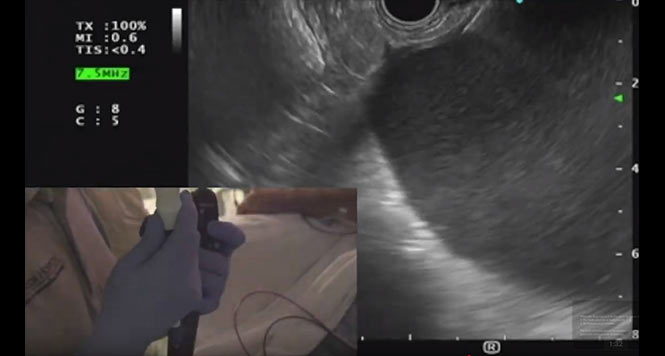Effectiveness of EUS Gallbladder Drainage as Primary Therapy for Malignant Biliary Obstruction
Rajesh N. Keswani, MD, MS, reviewing Mangiavillano B, et al. Dig Endosc 2023 May 30.
ERCP is generally the first-line approach for palliation of distal malignant biliary obstruction (DMBO), but interest in the use of endoscopic ultrasound (EUS)-guided transmural drainage of the obstructed biliary tree is increasing. Although EUS biliary drainage is the most studied, technical considerations may make the placement of a transmural stent into the obstructed bile duct more challenging and prone to adverse events. An alternative approach is direct EUS gallbladder drainage (EUS-GBD), which provides a much larger target (the distended gallbladder) for transmural drainage but still can relieve jaundice when the cystic duct is patent.
In this study, Mangiavillano et al prospectively studied the effectiveness and safety of EUS-GBD in 37 patients with DMBO. Relevant exclusion criteria included malignant cystic duct obstruction on imaging and altered gastrointestinal anatomy. All procedures were performed using a single type of electrocautery-enhanced lumen-apposing metal stent (EC-LAMS; Hot-Spaxus; Taewoong Medical Co, Ltd, Goyang-si, Korea). The EUS-GBD technique was not standardized and was performed either freehand or over a guidewire placed into the gallbladder. Furthermore, an EC-LAMS was placed either transgastric or transduodenal, based on which location the endoscopist selected as more ideal.
Of 40 patients who fulfilled the inclusion criteria, 3 were found to have malignant cystic duct obstruction on EUS and excluded from the study. Of the remaining 37 patients, 23 (62.1%) had DMBO due to pancreatic adenocarcinoma. Technical and clinical success (defined as >50% reduction in preprocedure bilirubin at 14 days) were achieved in all patients. One patient experienced gastrointestinal bleeding after 24 hours and required interventional radiology treatment, one patient had LAMS food impaction at approximately two weeks, and two patients had recurrent jaundice from tumor-related cystic duct occlusion, requiring alternative interventions.

COMMENTThis small prospective study provides additional data supporting the use of primary EUS-GBD for distal malignant biliary obstruction. However, EUS-GBD requires a patent cystic duct to be efficacious, which may be somewhat challenging to ascertain on EUS or cross-sectional imaging. Furthermore, the long-term durability of this treatment requires further study as there is a concern that the cystic duct will ultimately become obstructed by an advancing tumor.
Note to readers: At the time we reviewed this paper, its publisher noted that it was not in final form and that subsequent changes might be made.
CITATION(S)
Mangiavillano B, Moon JH, Facciorusso A, et al. Eus-guided gallbladder drainage as a first approach for jaundice palliation in unresectable malignant distal biliary obstruction: a prospective study. Dig Endosc 2023 May 30. (Epub ahead of print) (https://doi.org/10.1111/den.14606)


